
Texas Warblers
Back Yard Bird Pictures here (Newer, 2008)

These guys have an amazing range of motion in their necks. Thanks to Gil who identified the cormorant. Gil notes "...has an eye than looks greener than most; usually they are a striking turquoise color that is uncommon in nature." Part of the reason is that a range of the colors we call "turquoise" is outside the gamut of the sRGB color space (which is all web images support). 1/13/2008 at Lake Woodlands. Nikon D200, Nikon 300 f4 AF-S lens, sometimes with a Tamron 1.4x TC.

The buoys are popular spots with the cormorants, and pretty much all the feathered denizens of Lake Woodlands.

Speaking of interesting eye colors, check out these guys. American coot picture, Fulica americana.

Above, the tern on the left swung around to have the sun at its back as it challenges the current buoy holder. Thanks to Gil for the ID and correcting me for calling them "gulls" ;-)... You can see a few cormorants in the background. Forster's Tern = Sterna forsteri. New 300mm lens & 1.4x teleconverter at f5.6, shutter 1/640s, a ~25% crop of full frame.

5/3/2008, I don't recall ever seeing a bird like this; I thought it was some sort of big duck. Gil advises: Your photo is an adult Egyptian goose, Alopochen aegyptiacus. Males and females look alike, except the male is slightly larger. This species is common throughout most of its current range, which is subsaharan Africa. It has been extirpated from its historic range in the Nile delta, Israel, and Eastern Europe in the Danube drainage. It is a common feral fowl in England. Here in Sacramento, over 100 individuals at a residential subdivision lake started spreading out to the rivers, so Fish and Game came in and wiped them out.


This is a montage of Barn Swallow pictures from the dam at the south end of Lake Woodlands. I tried to catch them in flight and didn't have much luck. I couldn't figure out what they were from my bird books. Gil advises: This is a group of fledgling Barn swallows, Hirundo rustica. The reason that they don't match the illustration in your guide, is that no one ever looks DOWN on a Barn swallow. Swallows are usually observed in flight and sitting high on wires, so your guide will show the undersides instead of the topside. Christina corroborates: I believe these are barn swallows. Nests are mud under the bridge. You see them flying low around the lake's edge on East Shore and North Shore (probably also south Shore, though I am not there). Note long forked tail. They do look young. Juveniles have less intense rusty face and throat than adults. But blue-black uppersides. You get great shots!
|
|
 Bird Pictures (my main bird pictures page) |  A Killdeer through the my Takahashi TOA 130 Telescope! |
This link: Birds from Brazos Bend 2007 trip (White Ibis, Little Blue Heron, Common Morhens, American Coots, Blackbellied Whistling Ducks, Red Earred Sliders (turtles)
You should check out the Hummingbird and the Big Woodpecker page, too, along with Birds on my main bird page.
Copyright © 2003-2008 Dick Locke. All Rights Reserved.
Image Use Information